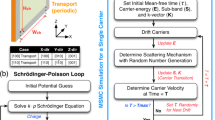Abstract
Modulation doping is a promising means of increasing the electrical conductivity of thermoelectric (TE) materials and achieving a high figure of merit (ZT). We compared, qualitatively and quantitatively, the TE performance of a field-effect density modulated Si nanowire channel of diameter D = 12 nm with that of its doped counterpart, by use of self-consistent atomistic tight-binding simulations coupled to the Boltzmann transport equation. We describe the simulation model, and show that as a result of a large improvement in electrical conductivity, gating, rather than doping, can result in greater than three-fold improvement of the TE power factor. Despite the large increase in the electronic part of the thermal conductivity, the total thermal conductivity is still dominated by phonons. Thus, a ZT more than three-fold higher can also be achieved in the gated channel compared with the doped channel. Finally, we show that the power factor peak is obtained when the Fermi level resides ∼k B T below the band edge, as is observed for doped channels.
Similar content being viewed by others
References
N. Neophytou and H. Kosina, Phys. Rev. B 83, 245305 (2011).
M. Zebarjadi, G. Joshi, G. Zhu, B. Yu, A. Minnich, Y. Lan, X. Wang, M. Dresselhaus, Z. Ren, and G. Chen, Nano Lett. 11, 2225 (2011).
B. Yu, M. Zebarjadi, H. Wang, K. Lukas, H. Wang, D. Wang, C. Opeil, M. Dresselhaus, G. Chen, and Z. Ren, Nano Lett. 12, 2077 (2012).
B.M. Curtin, E.A. Codecido, S. Krämer, and J.E. Bowers, Nano Lett. 13, 5503 (2013).
Y. Tian, M.R. Sakr, J.M. Kinder, D. Liang, M.J. MacDonald, R.L.J. Qiu, H.-J. Gao, and X.P.A. Gao, Nano Lett. 12, 6492 (2012).
J. Moon, J.-H. Kim, Z.C.Y. Chen, J. Xiang, and R. Chen, Nano Lett. 13, 1196 (2013).
B.M. Curtin and J.E. Bowers, J. Appl. Phys. 115, 143704 (2014).
W. Liang, A.I. Hochbaum, M. Fardy, O. Rabin, M. Zhang, and P. Yang, Nano Lett. 9, 1689 (2009).
A.I. Hochbaum, R. Chen, R.D. Delgado, W. Liang, E.C. Garnett, M. Najarian, A. Majumdar, and P. Yang, Nature 451, 163 (2008).
A.I. Boukai, Y. Bunimovich, J.T. Kheli, J.-K. Yu, W.A. Goddard III, and J.R. Heath, Nature 451, 168 (2008).
N. Neophytou, O. Baumgartner, Z. Stanojevic, and H. Kosina, Solid State Electron. 90, 44 (2013).
T.B. Boykin, G. Klimeck, and F. Oyafuso, Phys. Rev. B 69, 115201 (2004).
G. Klimeck, S. Ahmed, H. Bae, N. Kharche, S. Clark, B. Haley, S. Lee, M. Naumov, H. Ryu, F. Saied, M. Prada, M. Korkusinski, and T.B. Boykin, IEEE Trans. Electron. Dev. 54, 2079 (2007).
N. Neophytou, M. Wagner, H. Kosina, and S. Selberherr, J. Electron. Mater. 39, 1902–1908 (2010).
S. Lee, F. Oyafuso, P. Von Allmen, and G. Klimeck, Phys. Rev. B 69, 045316 (2004).
G.D. Mahan and J.O. Sofo, Proc. Natl. Acad. Sci. USA 93, 7436 (1996).
T.J. Scheidemantel, C. Ambrosch-Draxl, T. Thonhauser, J.V. Badding, and J.O. Sofo, Phys. Rev. B 68, 125210 (2003).
S. Jin, M.V. Fischetti, and T.-W. Tang, J. Appl. Phys. 102, 083715 (2007).
H. Sakaki, T. Noda, K. Hirakawa, M. Tanaka, and T. Matsusue, Appl. Phys. Lett. 51, 1934 (1987).
K. Uchida and S. Takagi, Appl. Phys. Lett. 82, 2916 (2003).
E.B. Ramayya, D. Vasileska, S.M. Goodnick, and I. Knezevic, J. Appl. Phys. 104, 063711 (2008).
N. Neophytou and H. Kosina, Phys. Rev. B 84, 085313 (2011).
H.J. Ryu, Z. Aksamija, D.M. Paskiewicz, S.A. Scott, M.G. Lagally, I. Knezevic, and M.A. Eriksson, Phys. Rev. Lett. 105, 256601 (2010).
N. Neophytou and H. Kosina, J. Appl. Phys. 112, 024305 (2012).
K. Rameshan, N.A. Wong, K. Chan, S.P. Sim, and C.Y. Yang, Solid-State Electron. 46, 153 (2002).
H. Karamitaheri, N. Neophytou, and H. Kosina, J. Electron. Mater. 43, 1829 (2014).
H. Karamitaheri, N. Neophytou, and H. Kosina, J. Appl. Phys. 115, 024302 (2014).
Acknowledgment
The work leading to these results has received funding from the European Community’s Seventh Framework Programme under grant agreement no. FP7-263306, and the Austrian Science Fund FWF under project number P25368.
Author information
Authors and Affiliations
Corresponding author
Rights and permissions
About this article
Cite this article
Neophytou, N., Karamitaheri, H. & Kosina, H. Use of Field-Effect Density Modulation to Increase ZT for Si Nanowires: A Simulation Study. J. Electron. Mater. 44, 1599–1605 (2015). https://doi.org/10.1007/s11664-014-3488-4
Received:
Accepted:
Published:
Issue Date:
DOI: https://doi.org/10.1007/s11664-014-3488-4



